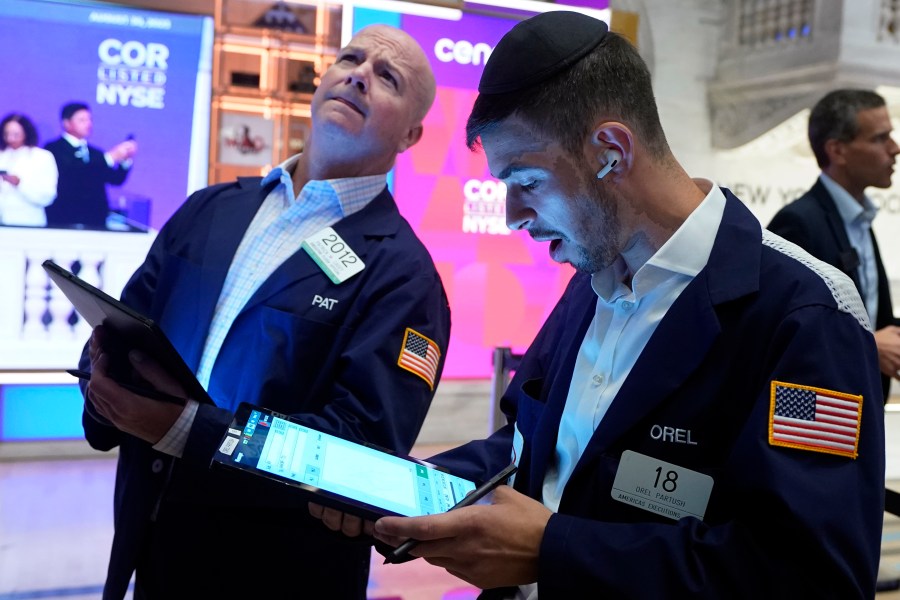Business
GDP, corporate profits soar as Biden calls out companies for ‘price gouging’ on November 30, 2023 at 11:00 am Business News | The Hill

The American economy grew in the third quarter, but there are signs that its growth is beginning to slow.
U.S. gross domestic product (GDP) came in Wednesday at a revised 5.2 percent increase in the third quarter, higher than the 4.9 percent pop of the initial estimate, to hit the fastest quarterly rate of growth in almost two years.
Corporate profits increased by $105.7 billion in the third quarter, compared to $6.9 billion in the second, the Commerce Department reported Wednesday.
What that 5.2 percent GDP number means
The latest GDP number is the highest since the fourth quarter of 2021, when it hit 7 percent and the economy was still seeing explosive quarterly growth in the recovery from pandemic shutdowns.
Despite consecutive quarters of negative growth in the first half of 2022, a strong job market and consumer spending pushed the economy out of recession range.
A major contraction predicted by many following the booming recovery has yet to materialize, adding to the likelihood that the economy could achieve a “soft landing” on a path to more regular growth.
Consumer spending continues to heat up
Personal consumption expenditures increased 3.6 percent in the third quarter, up from 0.8 percent in the second quarter, with advances in both goods and services spending.
Spending was up notably in recreational goods and vehicles and in recreational services, such as concerts and movies.
“The increase in real GDP reflected increases in consumer spending [and] private inventory investment,” the Commerce Department noted.
Corporate profits come in for rough criticism
Earlier this week, President Biden called out the role of private-sector profit-gouging in inflation.
“Let me be clear,” he said Monday. “To any corporation that has not brought their prices back down, even as inflation has come down, even supply chains have been rebuilt — it’s time to stop the price gouging, [give] the American consumer a break.”
Upward revisions to fixed capital investments and state and local government spending drove the higher GDP number, while robust consumer spending was marked down slightly in the third quarter to a 3.6-percent increase.
“Economic growth was even better than expected in the third quarter, with real GDP rising 5.2 percent versus the advance estimate of 4.9 percent. The additional boost came from 2 sources: investments and government spending,” Sonu Varghese, a strategist at Carson Group, said in an analysis.
Gross domestic income (GDI), an inverse measure of economic productivity, came in at a more modest 1.5 percent. The average of real GDP and real GDI advanced 3.3 percent in the third quarter, up from 1.3 percent in the second.
Profits fly high while consumers face prices
While companies rake in massive profits, consumers are being hammered by prices that are as much as 20 percent higher than they were before the pandemic.
“Pandemic-era supply chain disruptions enabled corporations to hike prices and juice profit margins to highs not seen in more than 60 years,” Kitty Richards, director of Groundwork Collaborative, an economic research and advocacy group, wrote in an analysis.
“Now supply chains have returned to normal, but corporations in many sectors are still charging inflated prices and extracting exorbitant profit margins,” Richards said.
Corporate profits are now at the highest share of national income in more than 10 years.
“This means the labor share remains flat or declining, depending on the measure you use, in the third quarter. There’s still room to grow back to more historical ranges during this recovery,” Mike Konczal, director of macroeconomic analysis at the Roosevelt Institute, another research and advocacy organization, wrote.
“[It’s] good reason for the President to be flagging corporate profits alongside high prices,” he added.
Sixty percent of Americans say their income hasn’t kept pace with increases in daily expenses over the past year, according to research released Wednesday by market data company Bankrate. That’s up from 55 percent last year.
“Twenty-nine percent say their pay has kept up, compared to 33 percent last year. Older workers, lower income earners, and hourly workers are more likely to say their pay has not kept up with inflation,” the Bankrate analysis found.
The recession that won’t materialize
The latest GDP numbers come after a deluge of recession predictions from market commentators, economists and even authorities like the Federal Reserve, which forecast a “mild recession” earlier this year before scrapping that call at a later meeting.
“A US recession is effectively certain in the next 12 months,” economists with Bloomberg Economics wrote in October 2022.
The company’s recession probability model “forecast a higher recession probability across all timeframes, with the 12-month estimate of a downturn by October 2023 hitting 100 percent.”
Harvard University economist Larry Summers said last year that unemployment would need to skyrocket in order to tame inflation before eventually conceding that “transitory factors” contributing to inflation were easing.
Robust consumer spending, a red hot job market, knock-on effects from $1 trillion in pandemic stimulus, as well as longer-term investments spurred by big pieces of legislation have likely all been working in the opposite direction from a downturn, to varying degrees.
Inflation is coming down but pre-pandemic prices are likely gone forever
The pace of price increases in the economy has come down over the past year, and in a few sectors, such as durable goods, price levels have deflated. Annual price increases topped out at 9 percent last June and are now at 3.2 percent, according to the Labor Department’s consumer price index (CPI).
But price levels in absolute terms are still way higher than they were before the pandemic and have little chance of returning to their pre-pandemic norms.
An analysis released this week by Bloomberg Economics found that prices are an average of 20 percent higher across the economy than they were in January 2020.
Rent is up 20 percent, groceries are up 25 percent, electricity is up 25 percent, car insurance is up 33 percent and water is up 16 percent, the analysis found.
Dubbing it a “cost-of-living squeeze,” economists noted that “after accounting for inflation, hourly wages have barely budged since 2020.”
Cost-of-living stresses could be driving poor polling performance
Despite many strong metrics in the national accounting, ranging from consumer spending to the labor market, Americans are disapproving of President Biden’s handling of the economy.
Just 32 percent of respondents said Biden is handling the economy well, according to polling released Tuesday by Gallup.
Slightly stronger marks came in earlier this month from the Harvard CAPS-Harris poll.
That poll found that 44 percent of Americans approved of Biden’s economic stewardship, an increase from 41 percent last month.
White House spokesperson Karine Jean-Pierre echoed Biden’s remarks on the effect of profits and price-gouging on inflation Wednesday.
“Many corporations [have seen] input costs grow more slowly or even fall recently. Some companies are passing those savings on to consumers, but some aren’t,” she said.
“Companies should pass those savings on to consumers by lowering their high markups from the last two years,” Jean-Pierre said. “That’s why taking on price gouging has been part of the President’s economic agenda for more than two years now.”
The market has already priced in rate cuts
Wall Street is already pricing in rate cuts, meaning that the path to more regular growth following the recovery from the pandemic may already be laid out.
This would imply that the soft landing scenario desired by policymakers is already coming to pass.
On Monday, the Wall Street Journal reported that interest-rate futures were at 60-40 odds that “the Fed will lower rates by a quarter-of-a-percentage point by its May 2024 policy meeting.”
That’s up from 29 percent at the end of October, according to CME Group data, the Journal reported.
The U.S. central bank, in its latest summary of economic projections, is still officially predicting one more quarter-point rate hike this year, to max out at a range of 5.5 percent to 5.75 percent.
Administration, Business, News, Policy, corporate profits, GDP, gdp report, inflation, prices, Recession, recession fears The American economy grew in the third quarter, but there are signs that its growth is beginning to slow. U.S. gross domestic product (GDP) came in Wednesday at a revised 5.2 percent increase in the third quarter, higher than the 4.9 percent pop of the initial estimate, to hit the fastest quarterly rate of growth…
Business
Why 9 Million Americans Have Left

The Growing American Exodus
Nearly 9 million Americans now live outside the United States—a number that rivals the population of several states and signals a profound shift in how people view the American dream. This mass migration isn’t confined to retirees or the wealthy. Thanks to remote work, digital nomad visas, and mounting pressures at home, young professionals, families, and business owners are increasingly joining the ranks of expats.

Rising Costs and Shrinking Wallets
Living in the US has become increasingly expensive. Weekly grocery bills topping $300 are not uncommon, and everyday items like coffee and beef have surged in price over the last year. Rent, utilities, and other essentials also continue to climb, leaving many Americans to cut meals or put off purchases just to make ends meet. In contrast, life in countries like Mexico or Costa Rica often costs just 50–60% of what it does in the US—without sacrificing comfort or quality.
Health Care Concerns Drive Migration
America’s health care system is a major trigger for relocation. Despite the fact that the US spends more per person on health care than any other country, millions struggle to access affordable treatment. Over half of Americans admit to delaying medical care due to cost, with households earning below $40,000 seeing this rate jump to 63%. Many expats point to countries such as Spain or Thailand, where health care is both affordable and accessible, as a major draw.

Seeking Safety Abroad
Public safety issues—especially violent crime and gun-related incidents—have made many Americans feel unsafe, even in their own communities. The 2024 Global Peace Index documents a decline in North America’s safety ratings, while families in major cities often prioritize teaching their children to avoid gun violence over simple street safety. In many overseas destinations, newly arrived American families report a significant improvement in their sense of security and peace of mind.
Tax Burdens and Bureaucracy
US tax laws extend abroad, requiring expats to file annual returns and comply with complicated rules through acts such as FATCA. For some, the burden of global tax compliance is so great that thousands relinquish their US citizenship each year simply to escape the paperwork and scrutiny.
The Digital Nomad Revolution
Remote work has unlocked new pathways for Americans. Over a quarter of all paid workdays in the US are now fully remote, and more than 40 countries offer digital nomad visas for foreign professionals. Many Americans are leveraging this opportunity to maintain their US incomes while cutting costs and upgrading their quality of life abroad.

Conclusion: Redefining the Dream
The mass departure of nearly 9 million Americans reveals deep cracks in what was once considered the land of opportunity. Escalating costs, inaccessible healthcare, safety concerns, and relentless bureaucracy have spurred a global search for better options. For millions, the modern American dream is no longer tied to a white-picket fence, but found in newfound freedom beyond America’s borders.
Business
Will Theaters Crush Streaming in Hollywood’s Next Act?

Hollywood is bracing for a pivotal comeback, and for movie lovers, it’s the kind of shake-up that could redefine the very culture of cinema. With the freshly merged Paramount-Skydance shaking up its strategy, CEO David Ellison’s announcement doesn’t just signal a change—it reignites the passion for moviegoing that built the magic of Hollywood in the first place.

Theatrical Experience Roars Back
Fans and insiders alike have felt the itch for more event movies. For years, streaming promised endless options, but fragmented attention left many longing for communal spectacle. Now, with Paramount-Skydance tripling its film output for the big screen, it’s clear: studio leaders believe there’s no substitute for the lights, the hush before the opening credits, and the collective thrill of reacting to Hollywood’s latest blockbusters. Ellison’s pivot away from streaming exclusives taps deep into what unites cinephiles—the lived experience of cinema as art and event, not just content.
Industry Pulse: From Crisis to Renaissance
On the financial front, the numbers are as electrifying as any plot twist. After years of doubt, the box office is roaring. AMC, the world’s largest theater chain, reports a staggering 26% spike in moviegoer attendance and 36% revenue growth in Q2 2025. That kind of momentum hasn’t been seen since the heyday of summer tentpoles—and it’s not just about more tickets sold. AMC’s strategy—premium screens, with IMAX and Dolby Cinema, curated concessions, and branded collectibles—has turned every new release into an event, driving per-customer profits up nearly 50% compared to pre-pandemic norms.
Blockbusters Lead the Culture
Forget the gloom of endless streaming drops; when films like Top Gun: Maverick, Mission: Impossible, Minecraft, and surprise hits like Weapons and Freakier Friday draw crowds, the industry—and movie fans—sit up and take notice. Movie-themed collectibles and concession innovations, from Barbie’s iconic pink car popcorn holders to anniversary tie-ins, have made each screening a moment worth remembering, blending nostalgia and discovery. The focus: high-impact, shared audience experiences that streaming can’t replicate.
Streaming’s Limits and Studio Strategy
Yes, streaming is still surging, but the tide may be turning. The biggest franchises, and the biggest cultural events, happen when audiences come together for a theatrical release. Paramount-Skydance’s shift signals to rivals that premium storytelling and box office spectacle are again at the center of Hollywood value creation. The result is not just higher profits for exhibitors like AMC, but a rebirth of movie-going as the ultimate destination for fans hungry for connection and cinematic adventure.

Future Forecast: Culture, Community, and Blockbuster Dreams
As PwC and others warn that box office totals may take years to fully catch up, movie lovers and industry leaders alike are betting that exclusive theatrical runs, enhanced viewing experiences, and fan-driven engagement are the ingredients for long-term recovery—and a new golden age. The Paramount-Skydance play is more than a business move; it’s a rallying cry for the art of the theatrical event. Expect more big bets, more surprises, and—finally—a long-overdue renaissance for the silver screen.
For those who believe in the power of cinema, it’s a thrilling second act—and the best seat in the house might be front and center once again.
Business
Why Are Influencers Getting $7K to Post About Israel?

Influencers are being paid as much as $7,000 per post by the Israeli government as part of an expansive and sophisticated digital propaganda campaign. This effort is designed to influence global public opinion—especially among younger social media users—about Israel’s actions in Gaza and to counter critical narratives about the ongoing humanitarian situation.

How Much Is Being Spent?
Recent reports confirm that Israel has dedicated more than $40 million this year to social media and digital influence campaigns, targeting popular platforms such as TikTok, YouTube, and Instagram. In addition to direct influencer payments, Israel is investing tens of millions more in paid ads, search engine placements, and contracts with major tech companies like Google and Meta to push pro-Israel content and challenge critical coverage of issues like the famine in Gaza.
What’s the Strategy?
- Influencer Contracts: Influencers are recruited—often with all-expenses-paid trips to Israel, highly managed experiences, and direct payments—to post content that improves Israel’s image.
- Ad Campaigns: State-backed ad buys show lively Gaza markets and restaurants to counter global reports of famine and humanitarian crisis.
- Narrative Management: These posts and ads often avoid overt propaganda. Instead, they use personal stories, emotional appeals, and “behind the scenes” glimpses intended to humanize Israel’s side of the conflict and create doubt about reports by the UN and humanitarian agencies.
- Amplification: Paid content is strategically promoted so it dominates news feeds and is picked up by news aggregators, Wikipedia editors, and even AI systems that rely on “trusted” digital sources.
Why Is This Happening Now?
The humanitarian situation in Gaza has generated increasing international criticism, especially after the UN classified parts of Gaza as experiencing famine. In this environment, digital public relations has become a primary front in Israel’s efforts to defend its policies and limit diplomatic fallout. By investing in social media influencers, Israel is adapting old-school propaganda strategies (“Hasbara”) to the era of algorithms and youth-driven content.
Why Does It Matter?
This campaign represents a major blurring of the lines between paid promotion, journalism, and activism. When governments pay high-profile influencers to shape social media narratives, it becomes harder for audiences—especially young people—to distinguish between authentic perspectives and sponsored messaging.

In short: Influencers are getting $7,000 per post because Israel is prioritizing social media as a battleground for public opinion, investing millions in shaping what global audiences see, hear, and believe about Gaza and the conflict.

 Business3 weeks ago
Business3 weeks agoDisney Loses $3.87 Billion as Subscription Cancellations Surge After Kimmel Suspension

 Entertainment3 weeks ago
Entertainment3 weeks agoWhat the Deletion Frenzy Reveals in the David and Celeste Tragedy

 Entertainment4 weeks ago
Entertainment4 weeks agoABC Suspends ‘Jimmy Kimmel Live!’ Indefinitely After Kirk Remarks

 Entertainment3 weeks ago
Entertainment3 weeks agoExecutive Producer Debut: How Celia Carver Created Festival Hit ‘Afterparty’

 Business4 weeks ago
Business4 weeks agoThe Rise Of Bullsh*t Jobs: Why Gen Z Hates Work

 Health3 weeks ago
Health3 weeks agoRussia Claims 100% Success With New mRNA Cancer Vaccine

 Film Industry4 weeks ago
Film Industry4 weeks agoCan Movie Theaters Steal the Show from Streaming?

 News4 weeks ago
News4 weeks agoBody of Missing Teen Found in Tesla Linked to Musician D4vd




























